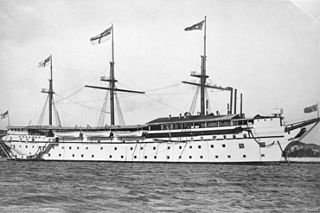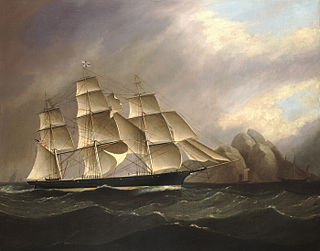
A clipper was a type of mid-19th-century merchant sailing vessel, designed for speed. Clippers were generally narrow for their length, small by later 19th century standards, could carry limited bulk freight, and had a large total sail area. "Clipper" does not refer to a specific sailplan; clippers may be schooners, brigs, brigantines, etc., as well as full-rigged ships. Clippers were mostly constructed in British and American shipyards, although France, Brazil, the Netherlands and other nations also produced some. Clippers sailed all over the world, primarily on the trade routes between the United Kingdom and China, in transatlantic trade, and on the New York-to-San Francisco route around Cape Horn during the California Gold Rush. Dutch clippers were built beginning in the 1850s for the tea trade and passenger service to Java.

Cutty Sark is a British clipper ship. Built on the River Leven, Dumbarton, Scotland in 1869 for the Jock Willis Shipping Line, she was one of the last tea clippers to be built and one of the fastest, coming at the end of a long period of design development for this type of vessel, which halted as steamships took over their routes. She was named after the short shirt of the fictional witch in Robert Burns' poem Tam o' Shanter, first published in 1791.

Thermopylae was an extreme composite clipper ship built in 1868 by Walter Hood & Co of Aberdeen, to the design of Bernard Waymouth of London. Designed for the China tea trade, she set a speed record on her maiden voyage to Melbourne of 63 days, still the fastest trip under sail.

Champion of the Seas was the second largest clipper ship destined for the Liverpool, England - Melbourne, Australia passenger service. Champion was ordered by James Baines of the Black Ball Line from Donald McKay. She was launched 19 April 1854 and was abandoned 3 January 1877, off Cape Horn.

Iron-hulled sailing ships represented the final evolution of sailing ships at the end of the age of sail. They were built to carry bulk cargo for long distances in the nineteenth and early twentieth centuries. They were the largest of merchant sailing ships, with three to five masts and square sails, as well as other sail plans. They carried lumber, guano, grain or ore between continents. Later examples had steel hulls. They are sometimes referred to as "windjammers" or "tall ships". Several survive, variously operating as school ships, museum ships, restaurant ships, and cruise ships.

Lightning was a clipper ship, one of the last really large clippers to be built in the United States. She was built by Donald McKay for James Baines of the Black Ball Line, Liverpool, for the Australia trade.

Blackadder was a clipper, a sister ship to Hallowe'en, built in 1870 by Maudslay, Sons & Field at Greenwich for Jock Willis & Sons.

Blackwall frigate was the colloquial name for a type of three-masted full-rigged ship built between the late 1830s and the mid-1870s.

James Baines was a passenger clipper ship completely constructed of timber in the 1850s and launched on 25 July 1854 from the East Boston shipyard of the famous ship builder Donald McKay in the United States for the Black Ball Line of James Baines & Co., Liverpool. The clipper was one of the few known larger sailing ships rigged with a moonsail.

In the middle third of the 19th century, the clippers which carried cargoes of tea from China to Britain would compete in informal races to be first ship to dock in London with the new crop of each season. The Great Tea Race of 1866 was keenly followed in the press, with an extremely close finish. Taeping docked 28 minutes before Ariel - after a passage of more than 14,000 miles. Ariel had been ahead when the ships were taken in tow by steam tugs off Deal, but after waiting for the tide at Gravesend the deciding factor was the height of tide at which one could enter the different docks used by each ship. The third finisher, Serica, docked an hour and 15 minutes after Ariel. These three ships had left China on the same tide and arrived at London 99 days later to dock on the same tide. The next to arrive, 28 hours later, was Fiery Cross, followed, the next day, by Taitsing.

Ravenscrag is the name of several ships, some being sailing vessels and some steamships. One of the sailing vessels is historically significant for bringing to the Hawaiian Islands in 1879 Portuguese immigrants who subsequently introduced the ukulele to island culture.

HMAS Tingira was a training ship operated by the Royal Australian Navy (RAN) between 1911 and 1927. Alexander Hall & Co. built the ship in Scotland in 1866 as the passenger clipper Sobraon; she was the largest composite-hull sailing vessel ever built. She sailed on an annual migration run between England and Australia until 1891, when she was sold to the colonial government of New South Wales for use as a reformatory ship. The vessel was then sold to the federal government in 1911, and entered RAN service. Tingira was paid off in 1927, but despite efforts to preserve the ship, was broken up in 1941.

Surprise was a California clipper built in East Boston in 1850. It initially rounded Cape Horn to California, but the vessel's owners, A. A. Low & Brother, soon found that the vessel performed well in Far Eastern waters. From that point onward the vessel spent much of her working life in the China trade, although the vessel also made three trips from the East Coast of the United States to California.

The Memnon was the first clipper ship to arrive in San Francisco after the Gold Rush, and the only clipper to arrive in San Francisco before 1850. Built in 1848, she made record passages to San Francisco and to China, and sailed in the first clipper race around Cape Horn.

Ocean Telegraph was a clipper ship that was built in Massachusetts in 1854 and was last known of in Gibraltar in 1923. She was in US ownership until 1863, when UK interests bought her and renamed her Light Brigade.

Stornoway was a British tea clipper built by Alexander Hall and Sons in Aberdeen, Scotland in 1850. She was a further development by Hall on the clippers built in Aberdeen in 1848, being larger and more obviously suited to deep sea service. She was ordered by Jardine Matheson specifically for the tea trade. In the late 1840s, tea was available earlier in the season in China, so the first ships to load had to beat to windward against the north-east monsoon to get across the China Sea. The details of the hull shape designed by Hall had this requirement in mind.

Orient was a wooden-hulled, three-masted sailing ship that was built in England in 1853 and scrapped in Gibraltar in 1925. She served in the Crimean War, and then spent two decades with James Thompson & Co's "Orient Line" of ships sailing between Great Britain and South Australia.

The SS Schomberg was a clipper built in Aberdeen by Alexander Hall & Co. for "the Black Ball line" for carrying large cargoes and steerage passengers, and to "outdo the Americans". When built, she was regarded as the most luxurious and well-built clipper of the period.

Scottish Maid was a Scottish packet boat, a two-masted wooden schooner, built at Alexander Hall and Sons' boatyard in 1839 for the Aberdeen Line. She has been described as the first clipper vessel to be built in Britain. Her design of sharp, forward-raked bow, later called the "clipper bow" or Aberdeen bow, pioneered a succession of larger clipper ships with many also built in Aberdeen on Scotland's northeast coast.






















